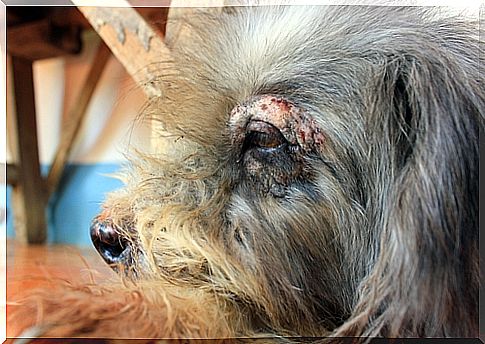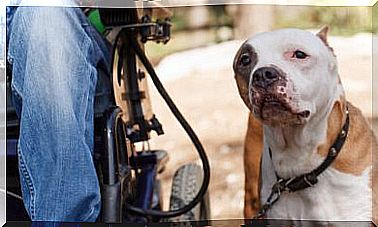Canine Atopic Dermatitis: How To Treat Your Dog

Does your dog scratch a lot on sensitive skin areas? Do you have redness, irritation or cracked skin? Are these areas inflamed? Does your dog have a family history of atopic dermatitis? If the answer to many of these questions is yes, then your dog is likely suffering from canine atopic dermatitis. Find out below some information about this disease and the remedies to treat it.
What is canine atopic dermatitis?
Canine atopic dermatitis is an inflammatory skin disease that has edema and cracking and is caused by an alteration of the immune system. To be even clearer, it is a type of allergy. It manifests itself with an alteration of the skin and the colonization and proliferation of microorganisms and inflammatory changes.
Canine atopic dermatitis is genetic, i.e. it depends on the genes of the animal and its family antecedents and therefore it is not a disease that can be cured. However, it can be treated to decrease symptoms and external manifestations, but the treatment will have to be maintained throughout life.
It occurs mainly in young dogs and there are breeds that have a certain predisposition to this disease. The breeds most at risk are the West Highland White Terrier, the Boxer, the Labrador, the Dalmatian, the Setter, the German Shepherd, the Shar Pei and the French Bulldog.
How to tell if my dog has atopic dermatitis?

Canine atopic dermatitis can be easily recognized because the sensitive areas of the skin (especially the face, inner ear area, neck, armpits, groin, abdomen, perineum, lower tail area, flexion of the limbs and the part that is between the fingers) have redness and pins.
Cracks and irritation may also appear in these areas. If the dog scratches himself, the skin will be hard, dark and our pet will begin to lose hair in these areas.
If it also occurs around the eyes or ears, this disease can cause otitis or conjunctivitis. For this reason, particular attention must be paid when atopic dermatitis affects these areas, and regularly apply the treatments and drugs prescribed by the veterinarian.
How can I relieve my dog’s discomfort?

Canine atopic dermatitis should only be treated if it is a problem for the dog; that is, if you scratch a lot, have bald patches or injure yourself.
Before carrying out any treatment, the dog will need to receive some attention. First you will need to check if you have fleas and you will need to take care of your skin, for example by eliminating possible infections. The owner of the dog should be willing to cooperate with the veterinarian at all times and keep in mind that the treatment does not eliminate the disease, but only decreases the itching and clinical manifestations.
There are three types of treatment to apply if we have a dog suffering from atopic dermatitis: topical treatment, immunotherapy and anti-itch medical treatment.
Topical treatment normally consists in the application of gels, creams and lotions that favor the restoration of the epidermis because they contain factors that regenerate the skin barrier. This prevents itching, moisturizes the skin and reduces the allergies that the dog manifests through the skin.
Immunotherapy consists of strengthening the dog’s antibodies and immune system. It can be applied in two ways: the allergen-specific one (also known as anti-allergic vaccine), which is oriented to the specific strengthening of the antibodies that have to face the allergen that causes the allergic reaction, or it can be applied through interferons that modulate the immune response. .
The latter treatment is aimed at treating the causes of canine atopic dermatitis, but it does not always manifest itself in a clinical way.
The third cure is medical treatment for itching. This treatment checks for the clinical signs of the disease; or cracks, redness, pins, itching, etc. It does not cure the disease, but it makes its symptoms tolerable for the animal. There are two variants of this treatment, one for acute episodes and the other consisting of a chronic treatment to prevent the onset of symptoms in the long term. It may include the use of drugs such as glucocorticoids, cyclosporine and fatty acids.
Unfortunately canine atopic dermatitis is a genetic disease, so there is no single therapy that is fully effective. Appropriate treatment is determined based on in-depth studies on each case. Remember that even if the disease cannot be cured, preventing your dog from suffering from the symptoms will make him healthier, calmer, and most importantly, happy.









